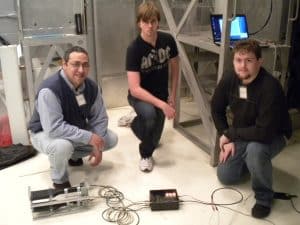
Dr. Abdel Bachri, assistant professor of physics at SAU, was awarded the grant to work on a research project related to cosmic radiation detection. Bachri, along with physics students Martin Hawron of New Boston, Texas, and Clayton Martin of Texarkana, Ark., spent two days at Johnson Space Center. The team was hosted by Dr. Thomas Wilson, a world-renowned NASA expert in space physics and high energy cosmic rays. Wilson advanced the idea that fundamental physics must be taken into space, where objects such as the moon and even the universe will ultimately become laboratories and observatories.
During the visit, the SAU team was granted access to the Radiation Counting Laboratory, a heavily shielded facility housed 60 feet underground. The lab was specially constructed to conduct experiments requiring low levels of background radiation. Bachri and the students set up their SAU-made cosmic radiation detector overnight and registered extragalactic cosmic muon particles even at that depth, proving that this kind of radiation can be highly energetic and is able to travel a significant distance inside the earth before finally losing its energy. The team also took similar measurements of radiation flux at sea-level near Clearwater Bay. These results will be part of a paper being prepared by the team.
Toward the end of their visit, the team took time to visit the retired Saturn V, a multistage liquid-fuel expendable rocket used by NASA’s Apollo and Skylab programs from 1967 until 1973.
